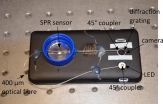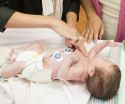Monitoring seawater reveals ocean acidification risks to Alaskan shellfish hatchery
NOAA, University of Alaska collaborate with shellfish hatchery
2015-07-01
(Press-News.org) New collaborative research between NOAA, University of Alaska and an Alaskan shellfish hatchery shows that ocean acidification may make it difficult for Alaskan coastal waters to support shellfish hatcheries by 2040 unless costly mitigation efforts are installed to modify seawater used in the hatcheries.
"Our research shows there could be significant effects from ocean acidification on Alaska's emerging shellfish hatchery industry in a matter of two and half decades," said Jeremy Mathis, Ph.D., an oceanographer at NOAA's Pacific Marine Environmental Laboratory and a co-author of the study, "On the Frontline: Tracking Ocean Acidification in an Alaskan Shellfish Hatchery," appearing today in PLOS ONE. "We need to continue to partner with industry and other stakeholders to make sure we're providing the environmental intelligence needed by industry to answer key questions and make decisions to meet these challenges."
The absorption of carbon dioxide primarily from human sources is making global oceans more corrosive to calcium carbonate minerals which shellfish need to build and maintain shells. The waters off Alaska are especially vulnerable to ocean acidification because the absorption of human-caused carbon dioxide emissions is not the only process contributing to acidity. Melting glaciers, upwelling of carbon-dioxide rich deep waters, the natural decomposition of plant-life that gives off carbon dioxide and the fact that cold water more readily absorbs carbon dioxide all exacerbate ocean acidification in the region.
A team of scientists from NOAA's Pacific Marine Environmental Laboratory in Seattle and the University of Alaska Fairbanks worked with the Alutiiq Pride Shellfish Hatchery in Seward, Alaska, to monitor seawater chemistry over a 10-month period from October 2013 to August 2014 to measure the potential effects of changing ocean chemistry on the growth of oyster, clam, scallop and other shellfish larvae or seed.
Researchers found that ocean chemistry off Seward fluctuates significantly by season. There is currently a five-month window during spring and summer when growing conditions favor larval shellfish, followed by periods of poor growing conditions in autumn and winter. But under some predicted scenarios for carbon dioxide emissions this five-month window for growing shellfish could close as early as 2040. The hatchery would then only be able to produce viable shellfish seed if it installed costly mitigation efforts to modify ocean water entering the facility.
While shellfish farming in Alaska involves mostly small-scale operations focused on oysters and mussels, stakeholder interest is growing and there is an effort underway to increase farmed shellfish production to a multi-million dollar annual level. Communities are embracing shellfish farming to diversify the local economy and create jobs. Currently, Alutiiq Pride is the only shellfish hatchery in Alaska that can provide seed stock to local residents that otherwise have to buy seed from outside the state. However, as the cost of producing seed stock increases in states like Washington and Oregon due to rising ocean acidification levels, hatcheries will be looking for alternative locations to supply large-scale operations. The growth of shellfish farming increases the need for effective monitoring of ocean waters.
"A key to tracking ocean acidification and its effects is our ability to make continuous robust measurements of the carbonate system in hatchery settings to understand how it varies over time," said Wiley Evans, Ph.D., of the University of Alaska Fairbanks, the lead scientist on the project. "We've come a long way in our ability to monitor ocean acidification."
Jeff Hetrick, owner of Alutiiq Pride and a longtime Alaska resident, explained why he wanted to participate in the research. "Ocean acidification has had major impacts on hatcheries in the Pacific Northwest and we wanted to evaluate what, if any, impacts could be expected here in Seward," Hetrick said. "The results have been alarming."
The study reinforces broader research showing that Alaska's commercial and subsistence fisheries are vulnerable to ocean acidification. Alaska is home to some of our nation's most valuable commercial and subsistence fisheries. NOAA's latest Fisheries of the U.S. report estimates that nearly 60 percent of U.S. commercial fisheries landings by weight are harvested in Alaska. These 5.8 billion pounds brought in $1.9 billion in wholesale values or one third of all landings by value in the U.S. in 2013.
Ocean acidification monitoring will continue at the Alutiiq Pride Shellfish Hatchery and will expand to at least one other site along the southeast Alaska coast in late 2015.
INFORMATION:
ELSE PRESS RELEASES FROM THIS DATE:
2015-07-01
Mandatory targets to reduce salt in processed food would help tackle inequalities in coronary heart disease that lead to excess deaths in deprived areas of England, according to research by the University of Liverpool.
Consuming high amounts of salt causes high blood pressure which increases the risk of cardiovascular disease. Current average UK salt intakes are around eight grams per adult per day, whilst the UK government recommends less than six grams per day. Individuals living in more deprived areas of England often consume larger amounts of salt, and this contributes ...
2015-07-01
Researchers at the Hanover Centre for Optical Technologies (HOT), University of Hanover, Germany, have developed a self-contained fiber optic sensor for smartphones with the potential for use in a wide variety of biomolecular tests, including those for detecting pregnancy or monitoring diabetes. The readings of the sensor can run through an application on a smartphone which provide real-time results. When properly provisioned, the smartphone-user has the ability to monitor multiple types of body fluids, including: blood, urine, saliva, sweat or breath. In case of medical ...
2015-07-01
BOSTON - Hospitals have made significant strides to reduce or eliminate physical harm to patients since the landmark 1999 Institute of Medicine Report "To Err is Human." In a new paper published in BMJ, patient care leaders at Beth Israel Deaconess Medical Center (BIDMC) say hospitals must now devote similar attention to eliminating emotional harms that damage a patient's dignity and can be caused by a failure to demonstrate adequate respect for the patient as a person.
"Emotional harms can erode trust, leave patients feeling violated and damage patient-provider relationships," ...
2015-07-01
LAWRENCE -- A new study that is the first to use Social Security Administration's personal income tax data tracking the same individuals over 20 years to measure individual lifetime earnings has confirmed significant long-term economic benefits of college education.
ChangHwan Kim, a University of Kansas researcher, said the research team was also able to account for shortcomings in previous studies by including factors such as gender, race, ethnicity, place of birth and high school performance that would influence a person's lifetime earnings and the probability of college ...
2015-07-01
A study by City College of New York physicists Flaviano Morone and Hernán A. Makse suggests that "smaller is smarter" when it comes to influential superspreaders of information in social networks. This is a major shift from the widely held view that "bigger is better," and could have important consequences for a broad range of social, natural and living networked systems.
"The problem of identifying the minimal set of influential nodes in complex networks for maximizing viral marketing in social media, optimizing immunization campaigns and protecting networks under ...
2015-07-01
ROCHESTER, Minn. - Opioid painkiller addiction and accidental overdoses have become far too common across the United States. To try to identify who is most at risk, Mayo Clinic researchers studied how many patients prescribed an opioid painkiller for the first time progressed to long-term prescriptions. The answer: 1 in 4. People with histories of tobacco use and substance abuse were likeliest to use opioid painkillers long-term.
The findings are published in the July issue of the medical journal Mayo Clinic Proceedings.
While the study identified past or present nicotine ...
2015-07-01
Premature babies are at an increased risk for developing autism spectrum disorder. But a small study indicates that preemies who avoid eye contact in early infancy are less likely to demonstrate symptoms of autism at age 2 than preemies who maintain eye contact during early interactions, according to new research at Washington University School of Medicine in St. Louis.
"Children with autism typically have challenges with social interaction and may avoid eye contact, but it turned out that children in this study who had characteristics of autism at age 2 were more likely ...
2015-07-01
ROSEMONT, Ill.--Participation in sports by women and girls has increased from 310,000 individuals in 1971 to 3.37 million in 2010. At the same time, sports-related injuries among female athletes have skyrocketed. According to a new study in the Journal of the American Academy of Orthopaedic Surgeons (JAAOS), women with symptoms known as the "female athlete triad" are at greater risk of bone stress injuries and fractures.
"The female athlete triad is a spectrum of symptoms that include low energy availability, menstrual cycle abnormalities, and low bone mineral density. ...
2015-07-01
There may be far fewer galaxies further out in the universe then might be expected, according to a new study led by Michigan State University.
Over the years, the Hubble Space Telescope has allowed astronomers to look deep into the universe. The long view stirred theories of untold thousands of distant, faint galaxies. The new research, appearing in the current issue of the Astrophysical Journal Letters, however, offers a theory that reduces the estimated number of the most distant galaxies by 10 to 100 times.
"Our work suggests that there are far fewer faint galaxies ...
2015-07-01
People have evolved to be smarter and taller than their predecessors, a study of populations around the world suggests.
Those who are born to parents from diverse genetic backgrounds tend to be taller and have sharper thinking skills than others, the major international study has found.
Researchers analysed health and genetic information from more than 100 studies carried out around the world. These included details on more than 350,000 people from urban and rural communities.
The team found that greater genetic diversity is linked to increased height. It is also ...
LAST 30 PRESS RELEASES:
[Press-News.org] Monitoring seawater reveals ocean acidification risks to Alaskan shellfish hatchery
NOAA, University of Alaska collaborate with shellfish hatchery




